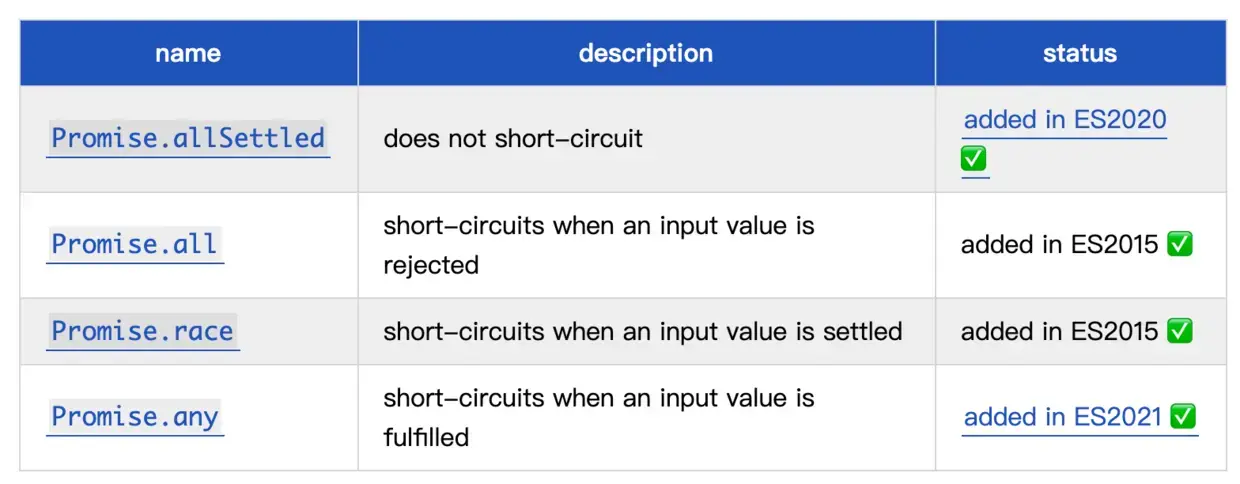You signed in with another tab or window. Reload to refresh your session.You signed out in another tab or window. Reload to refresh your session.You switched accounts on another tab or window. Reload to refresh your session.Dismiss alert
conststr="Linda is a self-taught developer.Linda will rule the world";letnewStr=str.replace("Linda","Micheal")//output: Micheal is a self-taught developer.Linda will rule the worldletnewStr=str.replaceAll("Linda","Micheal")//output: Micheal is a self-taught developer.Micheal will rule the world
以往如果需要替换所有匹配项的话,就要写成正则表达式,才能进行完全替换。
conststr="hello world, hello code";constnewStr=str.replace(/hello/g,"hi");console.log(newStr);// "hi world, hi code"
// 示例 2constpErr1=newPromise((resolve,reject)=>{reject('总是失败1');});constpErr2=newPromise((resolve,reject)=>{reject('总是失败2');});Promise.any([pErr1,pErr2]).catch((err)=>{console.log(err);})/**** Output ****/// "AggregateError: All promises were rejected"
// Logical Assignment Operator with || operatorletnum1letnum2=10num1||=num2console.log(num1)// 10// Line 4 can also be written as following ways// 1. num1 || (num1 = num2)// 2. if (!num1) num1 = num2
// Logical Assignment Operator with ?? operatorletnum1letnum2=10num1??=num2console.log(num1)// 10num1=falsenum1??=num2console.log(num1)// false// Line 4 can also be written as following ways// num1 ?? (num1 = num2)
// 创建 FinalizationRegistry:constreg=newFinalizationRegistry((val)=>{console.log(val)})(()=>{// 创建新对象:constobj={}//为 “obj” 对象注册 finalizer://第一个参数:要为其注册 finalizer 的对象。//第二个参数:上面定义的回调函数的值。reg.register(obj,'obj has been garbage-collected.')})()// 当 "obj" 被垃圾回收时输出:// 'obj has been garbage-collected.'
前言
2021年3月13日,ES2021 候选提案发布了其最终功能集的版本。如果它能够在今年6月的ECMA 大会上通过,就会成为官方的标准!
这个候选提案提及到ECMAScript新特性如下所示:
这些新的特性已经进入第四阶段且已添加到谷歌 Chrome V8 引擎中。接下来我们来介绍下这些ES2021的新特性吧。
String.prototype.replaceAll()
该方法返回一个新的字符串,所有
pattern会被传递给它的replacement替换。 其中pattern参数可以是字符串或正则表达式,replacement参数可以是字符串或针对每次匹配执行的函数。replaceAll方法是String.replace方法的续集,String.replace仅替换pattern的第一次找到的位置。以往如果需要替换所有匹配项的话,就要写成正则表达式,才能进行完全替换。
现在有了
String.prototype.replaceAll()即便是输入字符串也能完全替换匹配项。Promise.any
在 ES6 中引入了

Promise.race()和Promise.all()方法,ES2020 加入了Promise.allSettled()。 ES2021 又增加了一个使Promise处理更加容易的方法:Promise.any()Promise.any()接收一个Promise可迭代对象,只要其中的一个promise成功,就返回那个已经成功的promise(如示例 1 所示)。如果可迭代对象中没有一个promise成功(即所有的promise都失败/拒绝),就返回一个失败的promise和AggregateError类型的实例(如示例 2 所示),它是Error的一个子类,用于把单一的错误集合在一起。Promise.any()跟Promise.race()方法很像,只有一点不同,就是不会因为某个Promise变成rejected状态而结束。上面代码中,
Promise.any()方法的参数数组包含三个 Promise 操作。其中只要有一个变成fulfilled,Promise.any()返回的 Promise 对象就变成fulfilled,而Promise.race([p1, p2, p3])里面哪个结果获得的快,就返回那个结果,不管结果本身是成功状态还是失败状态。如果没有 fulfilled (成功的) promise,
Promise.any()返回AggregateError错误。逻辑运算符和赋值表达式(&&=,||=,??=)
在 JavaScript 中有许多赋值运算符和逻辑运算符,如以下基本示例:
新的提案让我们将能把逻辑运算符和赋值运算符结合起来
1、带有 && 运算符的逻辑赋值运算符
第3行的操作等价为:
x && (x = y)或者等价于
由于x是真实值,因此赋值了的值y,即2。简而言之,运算符
&&=仅当 LHS 值为真时,才将 RHS 变量值赋给 LHS 变量。2、带有||的运算符逻辑赋值运算符
仅当 LHS 值为假时,才将 RHS 变量值赋给 LHS 变量。
3、带有?? 运算符的逻辑赋值运算符
ES2020 引入了空值合并运算符,其也可以与赋值运算符结合使用。仅当 LHS 为 undefined 或仅为 null 时,才将 RHS 变量值赋给 LHS 变量。
数值分隔符
我们将通过使用_(下划线)字符在数字组之间提供分隔,使读取数值更加容易,提高可读性。
数值分隔符也适用于BigInt数字。
分隔符仅出于可读性目的。因此,它可以放置在数字中的任何位置。
WeakRef and Finalizers
此功能包含两个高级对象
WeakRef和FinalizationRegistry。根据使用情况,这些接口可以单独使用,也可以一起使用。**官方建议不要轻易使用WeakRef和finalizer。**其中一个原因是它们可能不可预测,另一个是它们并没有真正帮 gc 完成工作,实际上可能会垃圾回收的工作更加困难。在 JavaScript 中,当你创建了一个创建对象的引用时,这个引用可以防止对象被垃圾收集,也就是说 JavaScript 无法删除对象并释放其内存。只要对该对象的引用一直存在,就可以使这个对象永远存在。
ES2021 了新的类
WeakRefs。允许创建对象的弱引用。这样就能够在跟踪现有对象时不会阻止对其进行垃圾回收。对于缓存和对象映射非常有用。必须用
new关键字创建新的WeakRef,并把某些对象作为参数放入括号中。当你想读取引用(被引用的对象)时,可以通过在弱引用上调用deref()来实现。与
WeakRef紧密相连的还有另一个功能,名为finalizers或FinalizationRegistry。这个功能允许你注册一个回调函数,这个回调函数将会在对象被垃圾回收时调用。参考文章
The text was updated successfully, but these errors were encountered: